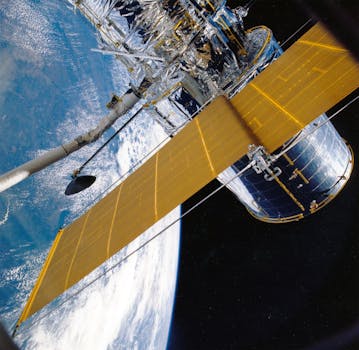The Future is Now: Exploring the Cutting-Edge Innovations in Satellite Telecommunications
The future of telecommunications is here, and it’s being led by cutting-edge innovations in satellite telecommunications. With advancements in technology, satellite telecommunications are becoming more efficient, reliable, and accessible, changing the way we communicate and access information.

Satellite Telecommunications is the future of telecommunications, and it’s being shaped by cutting-edge innovations that are transforming the industry. The use of satellites in telecommunications has been around for decades, but recent advancements in technology have made it more efficient, reliable, and accessible. In this article, we’ll explore the latest innovations in satellite telecommunications and how they’re changing the way we communicate and access information.
The development of new satellite constellations, such as OneWeb and SpaceX’s Starlink, is one of the most significant innovations in satellite telecommunications. These constellations consist of hundreds or even thousands of small satellites that work together to provide high-speed internet access to remote and underserved areas. This technology has the potential to bridge the digital divide and provide internet access to millions of people around the world who currently lack it.
Another significant innovation in satellite telecommunications is the use of advanced propulsion systems, such as electric propulsion and Hall effect thrusters. These systems allow satellites to maneuver more efficiently and extend their lifespan, reducing the need for costly and complex satellite replacements. Additionally, the use of 3D printing and other advanced manufacturing techniques is enabling the creation of smaller, lighter, and more efficient satellites that can be launched at a lower cost.
The Impact of Satellite Telecommunications on Global Communication
The impact of satellite telecommunications on global communication cannot be overstated. With the ability to provide high-speed internet access to remote and underserved areas, satellite telecommunications are bridging the digital divide and enabling people to access information, communicate with others, and participate in the global economy. This is particularly significant for developing countries, where access to traditional telecommunications infrastructure may be limited.
Satellite telecommunications are also playing a critical role in emergency response and disaster recovery. In the event of a natural disaster, satellite telecommunications can provide a vital link to the outside world, enabling emergency responders to coordinate relief efforts and communicate with affected communities. Additionally, satellite telecommunications can provide critical infrastructure support, such as navigation and timing signals, that are essential for modern society.
The Future of Satellite Telecommunications
As the demand for satellite telecommunications continues to grow, we can expect to see even more innovative technologies and applications emerge. One area of development is the use of quantum encryption, which has the potential to provide unbreakable encryption for satellite communications. This technology is still in its infancy, but it has the potential to revolutionize the way we secure our communications.
Another area of development is the use of satellite-based Internet of Things (IoT) networks. These networks have the potential to enable a wide range of applications, from smart cities to precision agriculture, and could have a significant impact on the way we live and work. Additionally, the development of new satellite constellations and the use of advanced propulsion systems will continue to drive down the cost of satellite telecommunications, making it more accessible to people around the world.
Challenges and Opportunities
While the future of satellite telecommunications is exciting, there are also challenges and opportunities that need to be addressed. One of the biggest challenges is the issue of space debris, which has the potential to interfere with satellite operations and pose a risk to the environment. To address this challenge, the development of sustainable and responsible space practices is essential.
Another challenge is the need for international cooperation and regulation. As the use of satellite telecommunications continues to grow, there is a need for clear and consistent regulations that can ensure the safe and responsible use of satellite technology. This will require cooperation between governments, industry, and other stakeholders to develop and implement effective regulations and standards.
In conclusion, the future of satellite telecommunications is now, and it’s being shaped by cutting-edge innovations that are transforming the industry. With the development of new satellite constellations, advanced propulsion systems, and other technologies, satellite telecommunications are becoming more efficient, reliable, and accessible. As the demand for satellite telecommunications continues to grow, we can expect to see even more innovative technologies and applications emerge, and it’s essential that we address the challenges and opportunities that arise to ensure the safe and responsible use of satellite technology.





